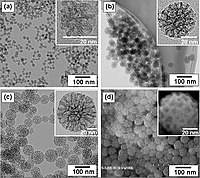
Photo from wikipedia
The influence of various solvents on structural and optical properties of zirconia (ZrO2) nanoparticles was successfully synthesized by via the facile solvothermal process at mild temperature of 180 °C. The aims… Click to show full abstract
The influence of various solvents on structural and optical properties of zirconia (ZrO2) nanoparticles was successfully synthesized by via the facile solvothermal process at mild temperature of 180 °C. The aims of this study were to identify how the solvents selection affects particle size and properties of the prepared materials. Structural characterization of the ZrO2 products using X-ray diffraction (XRD) and Fourier transform infrared spectroscopy (FTIR) revealed that the predominant crystal phase was the monoclinic phase. The scanning electron microscopy (SEM) and transmission electron microscopy (TEM) images display particles of spherical shapes in nature and size of diameters in the range of 5–6.5 nm. By changing the solvent, we observed variations in particle size. The optical properties of the products were studied by ultraviolet–visible (UV–Vis) and photoluminescence (PL) emission spectroscopy, which was confirmed that the prepared ZrO2 nanoparticles are promising good candidate inorganic material for optoelectronics applications and new lighting devices. Furthermore, we discussed the mechanism of the solvothermal process and the critical roles of boiling point of solvents in the solvothermal formation of the small-sized ZrO2 nanoparticles.
Journal Title: Journal of Materials Science: Materials in Electronics
Year Published: 2017
Link to full text (if available)
Share on Social Media: Sign Up to like & get
recommendations!